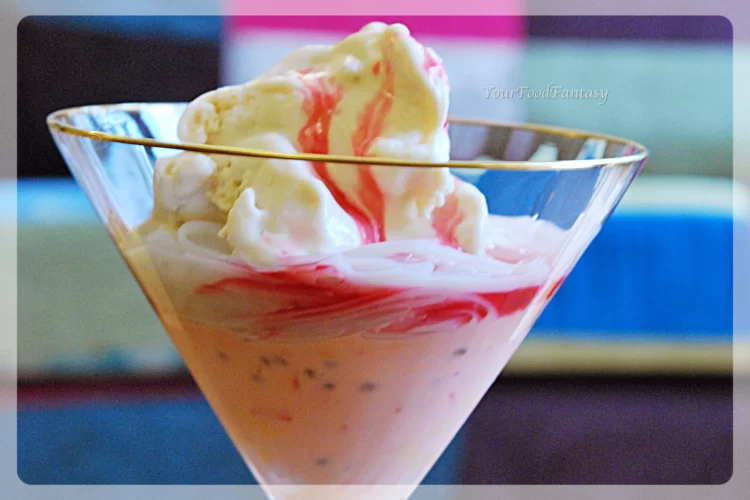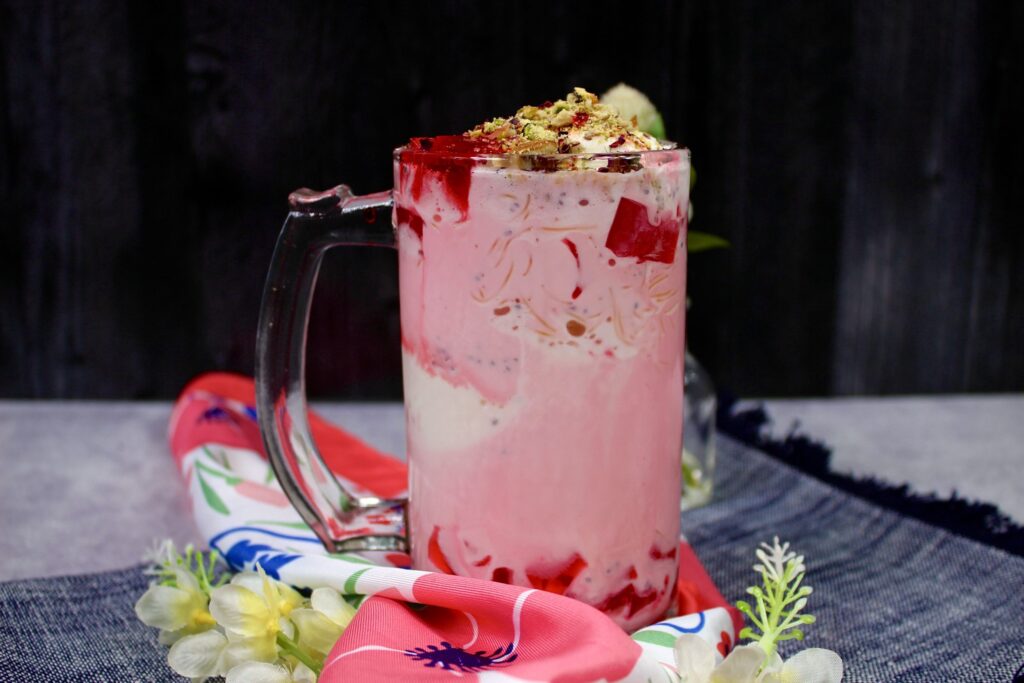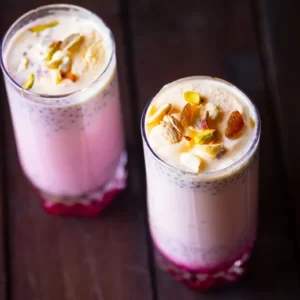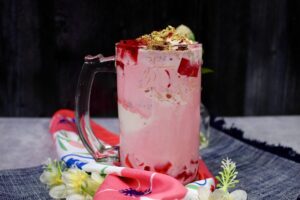Falooda is a popular Indian subcontinent dessert that may be found in countries such as India, Pakistan, Bangladesh, and Iran. It’s a cool, sweet, and refreshing treat ideal for hot summer days. Sweetened milk, vermicelli noodles, basil seeds, rose syrup, and ice cream is among the components used to make it. Fruit jellies, chopped fruits, and nuts are all options.
Sweetened milk, vermicelli noodles, basil seeds, rose syrup, and ice cream is among the components used to make Falooda. Fruit jellies, chopped fruits, and nuts are all options.
Vermicelli noodles are boiled in boiling water until soft, then washed with cold water and drained to make Falooda. Soak basil seeds in water until they swell. Rose syrup is added to sweetened milk and let to cool to room temperature. The ingredients are then piled in a tall glass, beginning with soaked basil seeds and vermicelli noodles, followed by cooled milk, and topped with an ice cream scoop. Falooda is typically served with a spoon and a straw and decorated with almonds or cherries. It is a wonderful and gratifying dish that people of all ages appreciate.
Falooda is typically served with a spoon and a straw and decorated with almonds or cherries. It is a wonderful and gratifying dish that people of all ages appreciate.
About Falooda:
- It is thought to have originated in India during the Mughal Empire when Mughal kings were famed for their love of rich and luxurious food.
- “Falooda” is derived from the Persian word “Faloodeh,” which means “cold and refreshing.”
- Its essential ingredients are milk, vermicelli noodles, basil seeds, and rose syrup, however, there are several variations. Some individuals add fruit jam, chopped fruits, or nuts to their Falooda, for example.
- It is frequently offered as a drink rather than a dessert in Iran. It’s created using thinner vermicelli noodles, lemon juice, and sugar.
- It is a cooling and pleasant dessert that can be savored after a day of fasting in Muslim households during Ramadan.
- This is a famous street meal in India and is supplied by vendors in various locations. It is also popular in restaurants, as well as at weddings and other special occasions.
- Some individuals prepare a non-dairy version of Falooda by substituting coconut milk or almond milk for regular milk.
The basic ingredients for making Falooda :
Vermicelli noodles: These are thin noodles produced from wheat flour or rice flour that are an important component of Falooda.
Milk: Sugar is added to the milk, which is then flavored with rose syrup or other substances.
Basil seeds: These little black seeds, also known as Sabja seeds, swell and become gelatinous when soaked in water. They give the dish a distinct texture.
Rose syrup: This is a rose-flavored syrup produced with sugar and water. It contributes to the peculiar flavor and scent of Falooda.
Ice cream: Typically, a scoop of vanilla ice cream is placed on top of the Falooda.
Optional ingredients that can be added to Falooda include:
Fruit jelly: This gives the dessert a blast of flavor and texture.
Chopped fruits: Popular flavors include mango, kiwi, and strawberry.
Nuts: As a garnish, almonds, pistachios, and cashews are popular.
Crushed ice: To make the Falooda more refreshing, this is introduced.
you can see more drinks recipes:
- Mango Squash Recipe
- Aam Panna Recipe
- Badam Shake Recipe (Almond Milkshake)
- Masala Chaas (Spiced Buttermilk)
- Orange Juice Recipe
Ingredients:
- 1/2 cup vermicelli noodles
- 4 cups milk
- 4 tablespoons sugar
- 2 tablespoons rose syrup
- 2 tablespoons basil seeds
- 4 scoops of vanilla ice cream
- Crushed ice
- Chopped nuts (optional)
Instructions:
- Soak the basil seeds in water for 10-15 minutes, until they swell up.
- In a pot of boiling water, cook the vermicelli noodles for 3-4 minutes, or until soft. Rinse with cold water after draining.
- In a second saucepan, bring the milk to a boil over medium heat.
- Add the sugar to the milk and stir until it dissolves completely.
- Turn off the heat and let the milk cool down to room temperature.
- Add the rose syrup to the milk and mix well.
- Take a tall glass and add a spoonful of soaked basil seeds to it.
- Add a spoonful of vermicelli noodles on top of the basil seeds.
- Pour the cooled rose milk over the noodles.
- Add a few spoonfuls of crushed ice to the glass.
- Top it off with a scoop of vanilla ice cream.
- Garnish with chopped nuts, if desired.
- Serve chilled with a spoon and a straw.
Tips and variation:
Tips:
- Soak the basil seeds in water for at least 15 minutes before using them in the recipe. This will give them enough time to swell up and become gelatinous.
- Use a tall glass to assemble the Falooda, as it will allow you to layer the ingredients more easily and create a visually appealing dessert.
- Add the ice cream to the top of the Falooda just before serving, as it will start to melt if you add it too early.
- You can adjust the sweetness and flavor of the Falooda by adding more or less sugar and rose syrup.
- It can be made in advance and stored in the fridge for a few hours before serving. However, the ice cream should be added just before serving.
Variation:
- Chocolate: Use chocolate syrup instead of rose syrup and add chocolate chips or cocoa powder to the milk for a chocolatey dessert.
- Kulfi: Use kulfi (a traditional Indian ice cream) instead of regular ice cream to make a more authentic version of Falooda.
- Vegan: Use almond milk or coconut milk instead of regular milk, and vegan ice cream instead of regular ice cream to make a vegan-friendly version of Falooda.
- Falooda with fruits and nuts: Add chopped fruits like kiwi, strawberry, and banana to the Falooda, along with chopped nuts like almonds and pistachios for added texture and flavor.
Serving suggestions:
- Top the Falooda with a scoop of ice cream, chopped nuts, and a cherry for an elegant presentation.
- Serve this with a spoon and a straw, so that you can enjoy both the milk and the solids.
- Garnish the Falooda with a sprinkle of rose petals, saffron strands, or edible gold dust for a touch of luxury.
- Serve the Falooda as a refreshing dessert on a hot summer day or as a special treat for guests at a dinner party.
- You can also make a large batch of Falooda and serve it in a punch bowl at a party or gathering.
Overall, it is a versatile dessert that can be customized to suit your taste preferences and served in a variety of ways.
FAQs:
Is Falooda healthy?
Ans: It is a dessert that is high in sugar and calories, so it should be consumed in moderation as part of a balanced diet.
What are the basil seeds used for in Falooda?
Ans: Basil seeds are used in Falooda as a thickening agent and to add texture to the dessert. When soaked in water, the seeds swell up and become gelatinous.
Can I make Falooda without ice cream?
Ans: Yes, you can make this without ice cream if you prefer. You can also use alternatives such as kulfi (a traditional Indian ice cream) or frozen yogurt.
Can I make Falooda in advance?
Ans: Yes, you can make it in advance and store it in the fridge for a few hours before serving. However, the ice cream should be added just before serving to prevent it from melting.
Can I make a vegan version of Falooda?
Ans: Yes, you can make a vegan version of this by using almond milk or coconut milk instead of regular milk, and vegan ice cream instead of regular ice cream.
Can I add fruits to this recipe?
Ans: Yes, you can add fruits such as mangoes, strawberries, and bananas to give it a fruity twist.
Nutrition:
- Serving size: 1 cup (240 ml)
- Calories: 360
- Total fat: 10g
- Saturated fat: 6g
- Cholesterol: 35mg
- Sodium: 150mg
- Total carbohydrates: 60g
- Dietary fiber: 1g
- Sugars: 45g
- Protein: 6g
You Might Also Like:
- Bharwa mirch achar recipe
- Amrood (guava) ki Sabji recipe
- A Paneer Chili recipe
- Veg Pulao recipe
- Bajra paratha recipe
follow us on instagram, facebook and youtube




